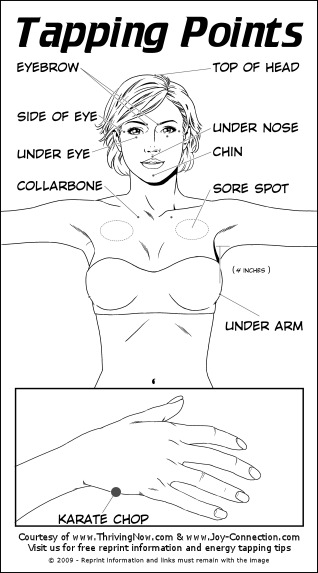eft


Emotional Freedom Techniques (EFT), more commonly known as tapping, has gained global recognition as a powerful and accessible tool for emotional healing and personal transformation. Blending the ancient energy-based wisdom of Chinese acupuncture with modern psychological understanding, EFT offers a unique and holistic approach to wellness—one that supports both emotional balance and physical relief.
Unlike traditional acupuncture, EFT does not require needles. Instead, it involves gentle tapping with the fingertips on specific meridian points of the body while focusing on a particular emotional issue or discomfort. This tapping process helps release energy blockages that are believed to contribute to emotional distress and physical tension, restoring a natural state of flow and calm within the body’s energy system.
Have you been diagnosed by a medical professional and either prescribed or been advised to take pain relief medication? Does it seem as if nothing else can be done medically except for your doctor to prescribe pain relief? Did you know that pain goes beyond simply being a measure of tissue damage?
The longer you’ve had the pain the more likely it is an old, redundant pain message from your mind that no longer serves a purpose. You’re consciously aware of it – all that is required is for us to convince your subconscious of it by applying the innovative OldPain2Go technique.
The roots of EFT can be traced to the groundbreaking work of psychologist Dr. Roger Callahan, whose method, Thought Field Therapy (TFT), laid the foundation for tapping-based techniques. In the 1990s, Gary Craig, a Stanford engineering graduate and certified NLP Master Practitioner, refined and simplified Callahan’s methods into what we now know as Emotional Freedom Techniques. Craig’s intention was to make energy psychology available to anyone, regardless of background or clinical training, while retaining its therapeutic impact.
Craig’s version of EFT was revolutionary in its simplicity and accessibility. By reducing complex treatment algorithms into a streamlined tapping sequence, he created a process that could be easily taught, self-applied, and used across a wide range of issues—from deep emotional trauma to everyday stress.
In recent years, EFT has moved from the fringes of alternative health into the realm of evidence-based practice, with an increasing number of clinical studies supporting its effectiveness. Peer-reviewed research has shown that EFT can significantly reduce symptoms associated with anxiety, depression, phobias, PTSD, and chronic pain.
One of the most striking findings is EFT’s ability to lower cortisol levels, the primary stress hormone. A landmark study found a 24% reduction in cortisol among participants after just one tapping session. Brain imaging and physiological monitoring also indicate that EFT influences both emotional reactivity and physical relaxation, aligning it with the benefits of mindfulness, meditation, and cognitive-behavioral techniques.
As science continues to explore the mind-body connection, EFT stands out as a practical and fast-acting method that directly engages both systems.
EFT begins by identifying a specific emotional issue or physical symptom that the person wants to address. This is followed by the creation of a setup statement, which affirms the problem while promoting acceptance (e.g., “Even though I feel anxious, I deeply and completely accept myself”).
The individual then taps on a sequence of meridian points—typically on the side of the hand, eyebrow, side of the eye, under the eye, under the nose, chin, collarbone, and under the arm—while repeating a reminder phrase to stay emotionally connected to the issue.
This tapping process often results in a measurable reduction in emotional intensity. Many clients describe feeling calmer, lighter, or more grounded after just one round. The process can be repeated until a state of resolution or emotional neutrality is reached.
While EFT is widely known for emotional support, its impact often extends into the physical realm. Many people report relief from:
*Chronic pain and tension
*Headaches and migraines
*Digestive disturbances linked to stress
*Fatigue and low energy
*Autoimmune flare-ups and nervous system dysregulation
Because EFT addresses the emotional root of physical symptoms, it can be a powerful complement to traditional healthcare or holistic therapies. At my North York practice, I regularly see clients whose physical discomfort improves once underlying emotional patterns are acknowledged and released.
Beyond symptom relief, EFT serves as a gateway to personal development and emotional resilience. Tapping can help release self-limiting beliefs, fear of failure, social anxiety, grief, shame, and self-doubt, paving the way for a stronger sense of self.
Individuals use EFT to boost confidence in public speaking, clear mental blocks in creative or professional work, and overcome inner resistance to change. It’s also a favorite among athletes, performers, and entrepreneurs looking to stay focused and emotionally aligned under pressure.
By calming the nervous system and shifting internal patterns, EFT empowers people to respond to life’s challenges with greater clarity, presence, and ease.
For those who wish to take their healing further, advanced EFT techniques provide tools for deeper work. These may include chasing the pain, the movie technique (used for trauma), reframing patterns, matrix reimprinting, and integration with visualization or inner child work.
As a practitioner, I tailor each session to the client’s needs—whether we are addressing long-standing trauma, clearing subconscious blocks, or simply creating space for calm. Every EFT journey is unique, and no two sessions are ever alike.
Emotional Freedom Techniques invite us to imagine what’s possible when we are no longer held back by fear, tension, or unprocessed emotion. The power of tapping lies in its simplicity, accessibility, and rapid results. And while the effects can be felt in a single session, the long-term benefits often emerge as clients develop a deeper relationship with their emotional well-being.
Whether you are navigating anxiety, looking to clear emotional pain, or simply curious about alternative methods of healing, EFT can meet you where you are—with gentleness, depth, and lasting change.
You can learn more about my approach and schedule a session by visiting contact
disclaimer: Results may vary from person to person



